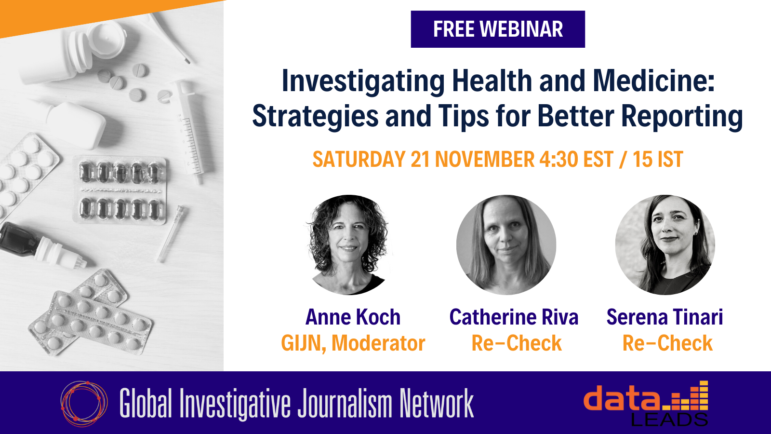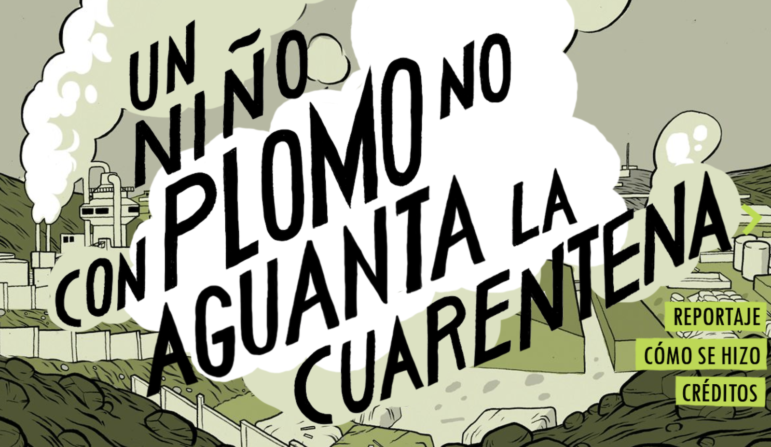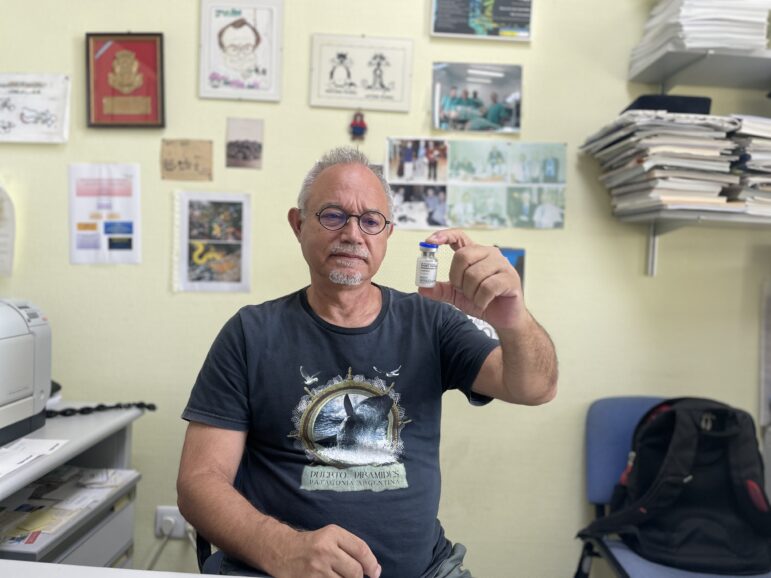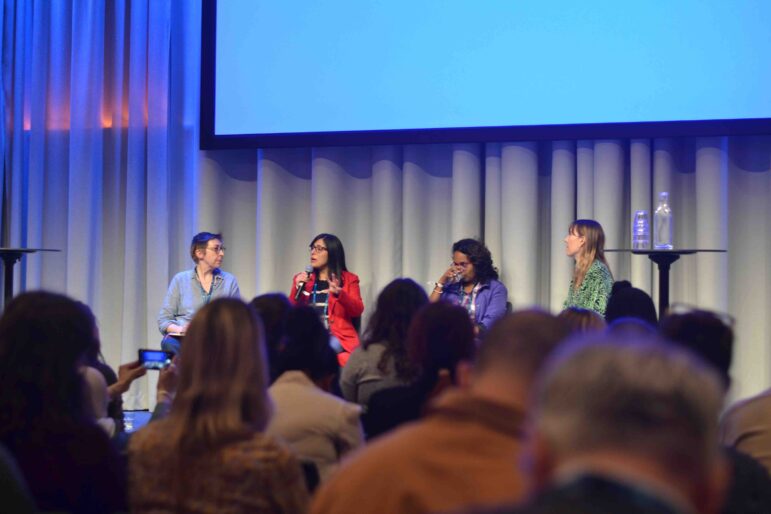

The Peruvian investigative journalist Fabiola Torres discusses investigating the global pharamaceutical industry at GIJC25. Image: Zahid Hassan for GIJN
How to Investigate Pharmaceutical Oligopolies
Around the world, access to essential medicines often depends less on scientific breakthroughs than on the market power of a few companies. Highly concentrated pharmaceutical markets can keep prices far above production costs, block competition, and leave patients dependent on expensive brands. The consequences are visible in hospitals and homes: rationed doses, skipped treatments, and families spending a significant share of their income simply to stay alive.
At the 14th Global Investigative Journalism Conference (GIJC25) in Kuala Lumpur, investigative journalist Fabiola Torres offered a practical framework for exposing how these oligopolies are built and maintained. Torres, the founder of the Peruvian health investigations outlet Salud con Lupa, led the project Your Money or Your Health, which examined why insulin remains unaffordable in Peru despite the invention being more than a century old.
Her central message was clear: “Investigating oligopolies of the pharma is about people’s lives. It is about inequality. What they do may be legal, but it’s a scandal.”
The Insulin Problem in Peru
Torres began the workshop with a case study familiar across the region: insulin. The original, 100-year-old, off-patent “human insulin” version of the drug should be cheap, widely available, and is recommended as the first-line treatment in international guidelines. But companies steer doctors and national guidelines toward newer patented “analogs” and device-based versions, making the original, affordable medicine harder to access.
Three companies, Novo Nordisk, Eli Lilly, and Sanofi, control roughly 90% of the global market. Their newer, analog versions remain under layers of fresh patents and device protections, creating what Torres called a “modern patent barrier” around an old drug.
In Peru, insulin manufacturers and importers receive tax exemptions, but prices have not fallen. Public hospitals frequently experience shortages, forcing patients to buy insulin privately, often spending 10–20% of a monthly minimum wage. When hospitals run out, people ration doses or go without, leading to complications, disability, or death.
Torres’s team discovered that in 2024, a new clinical guidance was issued in Peru that made an insulin analog the first-line treatment. “The draft changed at the last moment… the description was for Novo Nordisk’s insulin analogs,” she explained.
A key contributor to the guideline was a leading diabetes specialist who also heads a Novo Nordisk–funded pediatric diabetes program, a financial connection not reflected in the documentation circulated to the public.
The case illustrated how market power, regulation, and medical guidance intersect, and how journalists can follow each thread.
Invisible ‘Walls’ Behind High Drug Prices
Torres described how pharmaceutical oligopolies create a series of structural walls that determine who can access a medicine, and who cannot.
Torres said this concentrated market power allows a handful of companies to set the terms: which medicines enter the market, at what price. She explained how the oligopolies block cheaper, older, or biosimilar alternatives from reaching patients, who are ultimately paying the price.
- The Patent Wall
When a drug patent is coming to an end, “companies file new patents on very small changes,” Torres said. This often allows them to maintain their lucrative patent rights with just minor modifications: altered doses, updated devices, or manufacturing tweaks.
- The Regulatory Wall
Many countries lack complete frameworks for approving biosimilars, the lower-cost alternatives to complex biological drugs. In Peru, a biosimilar insulin has been approved since 2016, but remains constrained by regulatory gaps. Torres explained. Without clear guidance, Torres explained, doctors are less willing to prescribe biosimilar options.
- The Guideline Wall
Clinical guidelines adopted by each country are essential in shaping the prescribing habits and purchasing decisions. Peru’s guideline revisions demonstrated how undisclosed conflicts of interest can influence national policy, and shift markets toward corporate interest and higher-priced products.
- The Procurement Wall
Shortages, fragmented purchasing, and budget cuts make consistent access difficult. Torres documented long queues, reuse of syringes, and out-of-pocket purchases among families unable to obtain insulin through the public system.
- The Influence Wall
Companies fund medical events, training, and donation programs, often without transparent disclosure. “Most of the medical events are funded by the companies,” Torres noted. Donation programs from companies can often act as a commercial strategy to influence doctors and create market preference for their patented products.
These relationships can subtly shape prescribing norms and delay the uptake of lower-cost options.
Why These Stories Matter
Pharmaceutical oligopolies shape access to life-saving treatments, especially in low- and middle-income countries. Torres emphasized that uncovering these structures requires attention not only to patents and regulations, but also to the “human impact” behind each barrier.
What Journalists Can Do
Torres offered practical steps for reporters investigating medicine markets:
- Start with one medicine: Identify an essential drug that is expensive or frequently in short supply. Look up its International Nonproprietary Names (INN), this will reveal its patent family.
- Use patent databases: Search WIPO Patentscope, USPTO, and Espacenet to map primary and secondary patents, including extensions and continuations.
- Compare guideline drafts: Request draft and final versions of clinical guidelines and identify unexplained changes.
- Analyze procurement and pricing: File FOIA requests. Compare national prices with independent production-cost estimates, such as this recent MSF diabetes and insulin costing study.
- Check conflicts of interest: Investigate links between medical experts and pharmaceutical companies; many are absent from official documentation.
- Document the human impact: Interview patients and doctors. Many investigations begin with a single case that reveals broader structural barriers.
For Torres, the lesson is that these markets can be understood and therefore challenged. With the right tools, journalists can expose the structures behind high prices and limited competition and help inform the public. The first step, she said, is simple: choose one medicine, follow its path through the system, and see where the trail leads.










